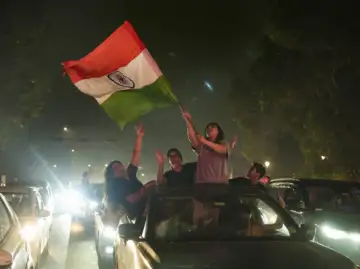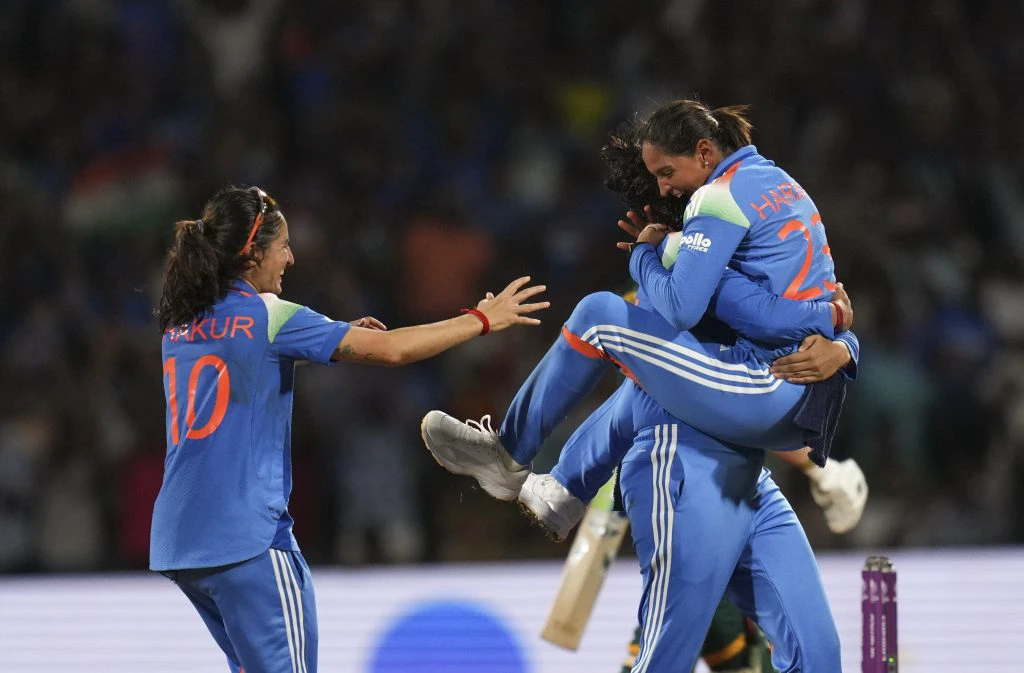Patriarchy in India is paleolithic in its thickness, towering in its effrontery, and glacial in its tenacity. And in the last decade or so, we have only dug deeper and deeper.
But there are days when something manages to crack open the ‘time-honoured’ armour patriarchy surrounds itself with. When Ibsen’s A Doll’s House premiered in Copenhagen in 1879, it was said that the sound of Nora Helmer closing the door behind her at the end of the play, in a gesture of defiant finality, was heard across the world.
Something similar may have happened on the second day of November. That Sunday midnight, a triumphant eleven, all women, in their shared camaraderie, their easy smiles, their candid demeanour, their carefree resolve and most importantly, their talent, won us all over. But more importantly, they also sent a message about sporting civility, about being oneself, and about not concocting their win with a shoddy show of macho hyper-nationalism. As is known, the masque of masculinity fears nothing more than women who are comfortable in their skins.
 I come to cricket not as a writer, historian, or journalist but only as an eager, if critical, spectator. And like many, my cricket consciousness has an identifiable beginning – the evening of Wednesday, June 22, 1983. India was playing England in the Prudential Cup semi-final. The crowd at Old Trafford was mostly white, flying the Union Jack was still a thing, and players wore white shirts with folded sleeves, and Panama hats. As the evening segued into the night here in India, there Sandip Patil hit the decisive boundary that sucked the delirious small crowd of Indians into the ground. Me, just short of seven, and my father, glued to the monochrome television inside our apartment in Bombay, felt a wave of unprecedented ecstasy.
I come to cricket not as a writer, historian, or journalist but only as an eager, if critical, spectator. And like many, my cricket consciousness has an identifiable beginning – the evening of Wednesday, June 22, 1983. India was playing England in the Prudential Cup semi-final. The crowd at Old Trafford was mostly white, flying the Union Jack was still a thing, and players wore white shirts with folded sleeves, and Panama hats. As the evening segued into the night here in India, there Sandip Patil hit the decisive boundary that sucked the delirious small crowd of Indians into the ground. Me, just short of seven, and my father, glued to the monochrome television inside our apartment in Bombay, felt a wave of unprecedented ecstasy.
As a nation we had barely known the sight of trophies, one of the tallest of which glittered in the June English sun, in the hands of Kapil Dev just days later. India had defeated the mighty West Indies. That week has now attained the mysticism of a lore. But nothing could obscure what we understood later: that after English language, cricket had the promise to become the new site of postcolonial assertion in that decade, and our rag-tag ‘social-welfare’ nation, decisively, even if clumsily, took up the mantle exactly where the Caribbeans had left it. For a decade it seemed there was a fulfillment of sociologist Ashis Nandy’s famous quip, “cricket is an Indian game accidentally discovered by the British”.
Why do I remember those days? Because last week those days resurfaced unannounced. Surely I was not the not only who saw Kapil Dev’s iconic 175 in Jemima Rodrigues’ singlehanded brio against Australia, an innings what was low on optics and high on purpose; neither was I the only one who saw a whiff of Mohinder Amarnath in Deepti Sharma’s all-round play in the final, or saw Kapil’s run away from the wicket to dismiss Viv Richards in Harmanpreet’s unforgettable climactic catch in the final.
 In this image received on November 4, 2025, Indian Women’s Cricket Team members’ signatures are displayed under their winning image during a felicitation event organised by the Chhatrapati Shivaji Maharaj International Airport as the team departs post their triumph. Photo: Handout via PTI
In this image received on November 4, 2025, Indian Women’s Cricket Team members’ signatures are displayed under their winning image during a felicitation event organised by the Chhatrapati Shivaji Maharaj International Airport as the team departs post their triumph. Photo: Handout via PTI
There are also other hints of that time today: no one gave a chance to Indian men in 1983, just like no one thought, till well into the middle of this tournament that the Indian women had a chance. So here was the story of the meek inheriting the earth, all over again, 42 years later. At least in cricket.
But there are differences in men’s and women’s cricket, in tone, if nothing else.
Consider what happened for much of those years in between? By mid-90s, the neoliberal market, smelling endless profit, galvanised cricket towards ends which barely sat well with the idea of the game. Cricket, to put it briefly, was first ‘carnivalised’, then caramalised, and then weaponised for the services of jingoism, especially in the last decade and a half or so. Every cricket match has become a ruse for overt brouhaha, braggadocio and sabre-rattling, stitched as it is now with pumped-up notions of national honour and global prominence. It seems that cricket is no more a subtle, clever game, but a gladiatorial arena where the hunger of million xenophobes have to be satiated. In other words, men’s cricket, willy-nilly, has become another province of bareknuckle masculine chest-thumping.
Last Sunday night, the women went against this grain and broke the mould, without even trying hard. Without painting their triumph with epic flourishes, one can safely say that they touched a chord in many of us who had long turned away from watching the game played by men.
After years it seemed that a bunch of eager sportspersons, with histories of gendered taunts and struggle written on them, have come to the pitch in the genuine spirit of the game, attended by a sense of resolve and comforted by a genuine display of what the French call jouissance; not as thick-jawed marauders a game away from their next ‘obvious’ victory. Also, gender may be the binding anchor of the woman’s team, but in its geographic, ethnic and caste diversity, it is also intersectional, a mirror of plurality that is India. To start with, they can well teach Indian men the ‘virtue’ and grace of going back to shaking hands with opponents after a match. Or shaking a leg without a care in the world. That would be a good beginning. The fences of patriarchy would come next.
But at the same time, to not express my deep concern would be to deify the women’s team. My caution comes from years of being fooled by the optics of cricket, and by the so-called vanguards of the game, all men, both inside and outside the playing field. Hence, I will hold my horses about the World Cup win being revolutionary, or ushering a new era of openness for women in sports. Patriarchy’s arms are, after all, long, and prejudice in this country is congenital. That’s always been the case.
 People celebrate after the Indian cricket team won the ICC Women’s World Cup 2025, near the India Gate in New Delhi, early November 3, 2025. Photo: PTI/Salman Ali
People celebrate after the Indian cricket team won the ICC Women’s World Cup 2025, near the India Gate in New Delhi, early November 3, 2025. Photo: PTI/Salman Ali
In this case I am also weary of corporate funds flooding the game’s actors a capite ad calcem. This has happened to the most formidable of talents in men’s cricket. So, sooner than we know, the ‘celebrity cricket superwomen’ will be managed by talent brokers, and made to tweet in accordance with the will of the regime in Delhi, sugary with praise for the dear leader. The assertion of gender, class and caste would all be sucked out in favour of pageantry and spectacle. I am not naive to expect overt rebellion, but the option is not always bland, unquestioned conformity either. If that happens, it would be nothing short of an epic tragedy.
And yet, a grizzled middle-aged cricket cynic like me would still like to hope; and hope that unlike the Indian state which oversaw the transformation of Indian men’s cricket, women’s cricket, for a change, will assert its fundamental decency and transform the Indian nation into a better version of itself.
